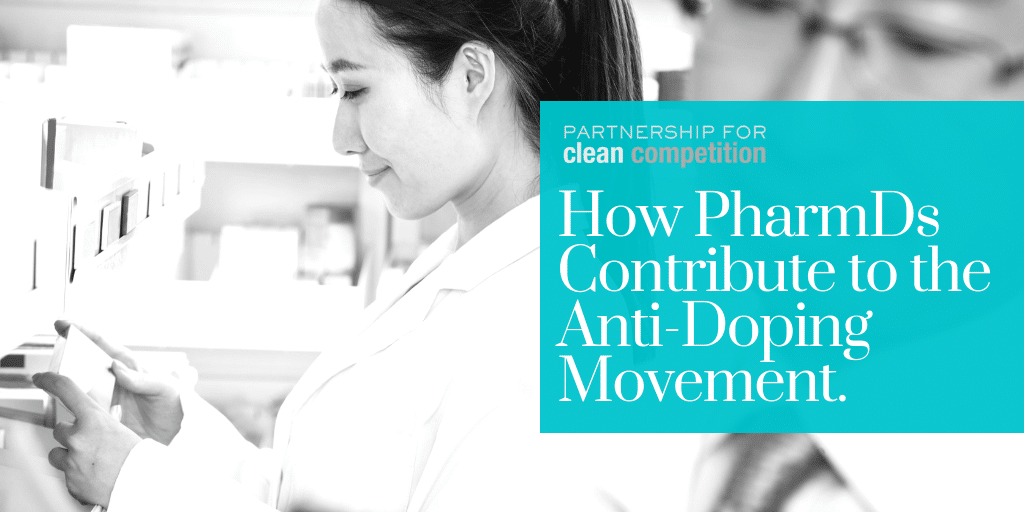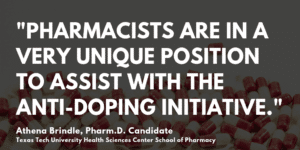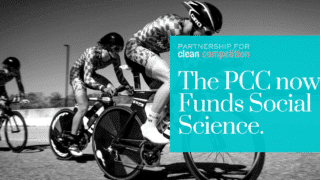Athena Brindle is a PharmD student at the Texas Tech University Health Sciences Center School of Pharmacy. She recently had the unique opportunity to intern at USADA, where she created a quick reference internal supplement ingredient database, learned about the Therapeutic Use Exemption Process, and worked with experts in the Drug Reference Program to understand the critical role pharmacists play in the anti-doping movement (hint: it’s larger than you might think).
What first inspired you to pursue opportunities in anti-doping?
My passion for sport medicine and the anti-doping initiative runs deep as a personal passion as well as a professional interest. Like geriatrics and pediatrics, athletes are a very unique patient population that require expertise in their medical care, as well as an understanding of their lifestyle and performance goals. Personally, I am driven towards a lifestyle of continuous education and growing into a more complete person every day. Athletes are remarkable examples of this, which brings me to a place where I want to continue to learn from them and assist them in achieving their goals in the safest and most ethical manner possible.
Who did you enjoy working with most at USADA?
I could not have asked for a better team, whether that be with Richard Mohr in the Drug Reference Department or with Tammy Hanson in the Education Department, and on. My direct supervisors were two contracted pharmacists, Ashley Anderson and Christine Witherspoon, that assist with the Drug Reference Line and serve as the drug experts in medications and supplements. Their mentorship motivated me and challenged me, simultaneously.
How could a PharmD contribute to the anti-doping movement?
Pharmacists are in a very unique position to assist with the anti-doping initiative. A Doctorate in Pharmacy requires 4 years of undergraduate education and 4 years of graduate education in didactic pharmacology courses and clinical rotations. Within these years of study, we are trained to understand pharmacokinetics and dynamics, medicinal chemistry, side effect profiles, and therapeutic uses. While our education does not focus on the athletic population, I strive to apply my knowledge towards this unique niche of patients. In any area where medications or biological substances can be consumed by individuals, pharmacists can be the bridge that combines clinical implications with bench side research. When evaluating drugs used in sport, critical aspects that pharmacists can contribute to understanding are the mechanism of a substance’s action in the body, their onset of action, half-life, therapeutic windows, side effects profiles, drug/substance interactions, disease/drug interactions, the potential of novel substances based on chemical profile, and much more.
What’s your ideal career path?
Since my first year of pharmacy school, I have been driven to explore the value pharmacists can bring into the areas of sports medicine and the anti-doping initiative. I have a love for clinical practice and a curiosity for translational research in these areas. For 2 years, I have shadowed many notable professionals in sports medicine including medical professionals for an NFL team and professionals at the U.S Olympic Training Center in Colorado Springs. Because pharmacists are not actively utilized in these areas, I hope to continue to learn about athletes’ medical needs. My time at USADA was an absolute dream come true and an incredible opportunity that has driven me to do more and experience more in this space. Now in my third year of pharmacy school, I am currently creating a novel rotation experience that will allow me to formally learn under a sports medicine physician and orthopedic surgeon for a 6 week-time period. During the next year until graduation in the spring of 2020, I am applying for pharmacy residency and fellowship programs that allow me to solidify my clinical skills in pharmacotherapy, but also allow me to grow my specialty in sports medicine and anti-doping. My dream is to be a drug reference resource for any professional who works with athletes and to truly understand their unique responsibilities of abiding within the standards of the WADA Code. I feel as clinicians, pharmacists can be a tool to ensure medications are being utilized appropriately during pre and post-operative care to speed athlete recovery and to help maintain physical health throughout their careers. While I strive towards clinical practice, my curiosity in understanding the pharmacological aspects of substances to a greater extent led me to consider a path that would bring me to the Partnership for Clean Competition Fellowship Program post-residency. One of the most exciting aspects of anti-doping for me is the fluidity of anti-doping research. There is always more research to be done to truly understand doping from a translational research aspect. I get so exciting thinking about being able to create a career path in this area.
Can you tell us about working with the experts in the Drug Reference Department?
The organization’s culture is phenomenal and the many experts I worked with on a day to day basis were incredible. My temporary intern position at USADA was created for me and allowed me to explore areas of anti-doping where pharmacists would be able to assist. During my time there, I created an internal supplement ingredient database as a quick reference to the types of supplements we see athletes consume on a regular basis. This process taught me how to identify high risk substances, high risk ingredients, and their standing on the WADA Prohibited List. On a weekly basis, I dove into the pharmacokinetic details of specific substances and their ergogenic uses. I also gained exposure to the Therapeutic Use Exemption Process allowing me to understand what conditions and medications are used in athletes with legitimate medical need.
What excites you about contributing to the clean sport movement?
During my time at USADA, I had the opportunity to share a presentation on Selective Androgen Receptor Modulators (SARMs) to all departments. In this presentation, I walked everyone through the use of SARMs from an athlete’s perspective; why do they use them, where do they get them, what are the adverse reactions seen, and the importance of being a resource for all athletes and professionals in this area. For me, being able to share my education and support a multidisciplinary team that is engaged with the movement of clean sport excites me. Acknowledging the good, the bad, the social science, and the hard science is so necessary to truly be able to move forward in this initiative.
Will you be applying for PCC support in the future?
While I have been given many amazing opportunities to learn about sports medicine and the anti-doping movement thus far, my journey in this area is just getting started. As mentioned, I am driven to become more knowledgeable in anti-doping both from the clinical aspect and the traditional research aspect. While my training is mostly clinical, my curiosity in research has brought me to inquire about the PCC Fellowship Program and has opened a whole new route for me to explore after graduation. At this time, I am unsure, but I am continuously learning more about my opportunities and anyway to contribute to this field is seen as an open door.
What’s the best piece of advice you’ve ever received?
I have a few pieces of advice that I carry with me through every part of my life and one specifically pertaining to what I learned at USADA about the art of doping:
- “Don’t let success go to you head and don’t let failure go to your heart.”
From my undergraduate education to now, I have had so many perceived failures and successes. I say perceived because I believe that we decide (for the most part) what constitutes a failure or a success. For me, I must constantly remind myself that it is okay to admit that I have failed or succeeded at something as long as I don’t let that moment become the defining moment of who I am as a whole.
- “You get in life what you have the courage to ask for.”
I truly believe that there are so many people out there that want to support your passion or mission and all they are wanting from you is for you to ask them for help, or guidance, or advice, or support. I am so thankful for all the opportunities I have been given that have created the person I am today, but they weren’t just given to me out of thin air. Opportunities were given to me because they understood my passion and I asked them for a chance to learn and contribute.
- “Sometimes, you must take your FDA approved pharmacotherapy “hat” off. Athletes use substances in a way that we were never taught.”
This is advice I received from a mentor at USADA. After hearing this, the whole process of how I evaluate substances for potential ergogenic effects completely changed in an instant.
We thank Athena for her candid responses, and passion for protecting clean athletes!
If you are a student interested in PCC opportunities, or wonder how your field of science may have applicability to the anti-doping movement, contact jcelmer@cleancompetition.org.





